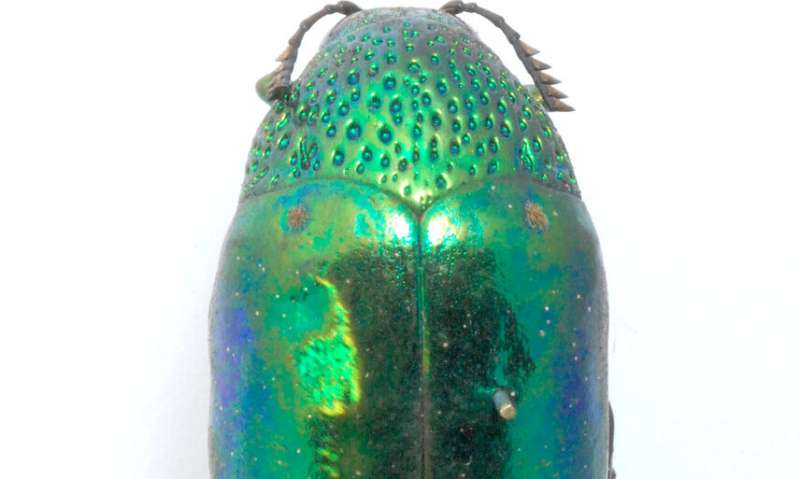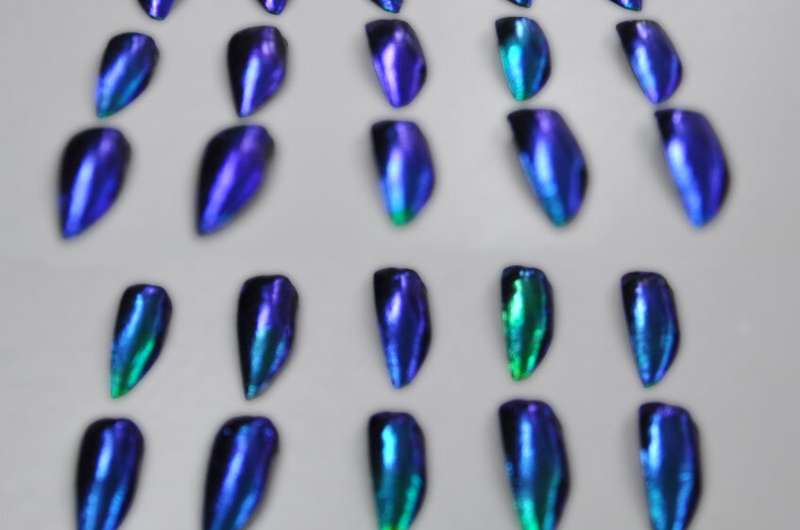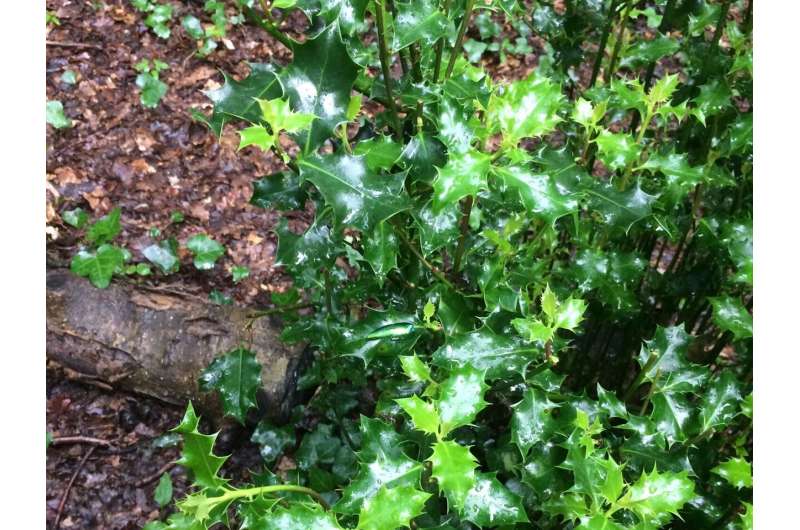A jewel beetle (Sternocera aequsignata). Credit: Bristol Museums, Galleries & Archives
Bright colors are often considered an evolutionary tradeoff in the animal kingdom. Yes, a male peacock's colorful feathers may help it attract a mate, but they also make it more likely to be seen by a hungry jungle cat. Jewel beetles (Sternocera aequisignata) and their green, blue, and purple iridescent wing cases may be an exception to the rule, researchers report January 23 in the journal Current Biology. They found that the insects' bright colors can act as a form of camouflage.
"The idea of 'iridescence as camouflage' is over 100 years old, but our study is the first to show that these early ignored or rejected ideas that 'changeable or metallic colors are among the strongest factors in animals' concealment' have traction," says first author Karin Kjernsmo, an evolutionary and behavioral ecologist at the University of Bristol, United Kingdom. "Both birds and humans really do have difficulty spotting iridescent objects in a natural, complex, forest environment."
Similar to an abalone shell or holographic trading card, iridescent objects change color depending on the angle from which they're viewed, creating a flashy, rainbow-like effect. This effect has made jewel beetles a staple in insect jewelry due to their vibrant color.
The researchers placed iridescent and dull-colored (green, purple, blue, rainbow, and black) wing cases attached to mealworms onto various plants in a natural field setting and then observed how often birds attacked each group. This was followed by a human detection test, where respondents searched for the wing cases in the field.
In this video, Karin Kjernsmo and her colleagues show that iridescence in prey can serve a counterintuitive function: concealment. They further show that the effects of this protective function are further enhanced by glossy backgrounds. This newly discovered function may explain the widespread occurrence of iridescence in many animals. Credit: University of Bristol / Kjernsmo et al.
Despite their gleam, Kjernsmo and her team found that the iridescent wing cases outpaced equally sized dull-colored wing cases at avoiding detection from birds and humans. Using both humans and birds is useful, Kjernsmo says, as with birds "you never know whether they can't see a prey item or if they see it but choose to ignore it. With human participants, you know exactly where the effects lie." Surprisingly, in both scenarios, the iridescent wing cases performed best (even beating leaf-colored green) at remaining undetected.
In addition, the ability to remain hidden became even more pronounced when the iridescent wing cases were placed against a glossy leaf background—adding "visual noise." Kjernsmo says that the masking ability of iridescence may be the result of "dynamic disruptive camouflage," which creates the illusion of inconsistent features and depth, confusing potential predators.
This photograph demonstrates the angle-dependent change in colors of the iridescent jewel beetle's wing case. Credit: Karin Kjernsmo
These results suggest that camouflage may be a primary function of iridescent structures in some species, reframing our current understanding behind its evolution and role in nature. "We don't for a minute imagine that the effect is something unique to jewel beetles; indeed, we'd be disappointed if it was," say Kjernsmo. "If we found that these beetles could be concealed by their colors, it increases the chances that many iridescent species could be using their colors this way."
Iridescent Jewel beetle taken duirng field experiment. Credit: Karin Kjernsmo and Jo Hall.
Next, Kjernsmo will use artificial intelligence to get a better understanding of the evolution of camouflage in the wild. She is working with senior author Innes Cuthill, a behavioral ecologist, and Nick Scott-Samuel, an experimental psychologist, both at the University of Bristol, using machine learning to evolve the optimal camouflage patterns for different environments and comparing those to real animal colors.
More information: Current Biology, Kjernsmo et al.: "Iridescence as Camouflage" www.cell.com/current-biology/f … 0960-9822(19)31608-2 , DOI: 10.1016/j.cub.2019.12.013
Journal information: Current Biology
Provided by Cell Press


























